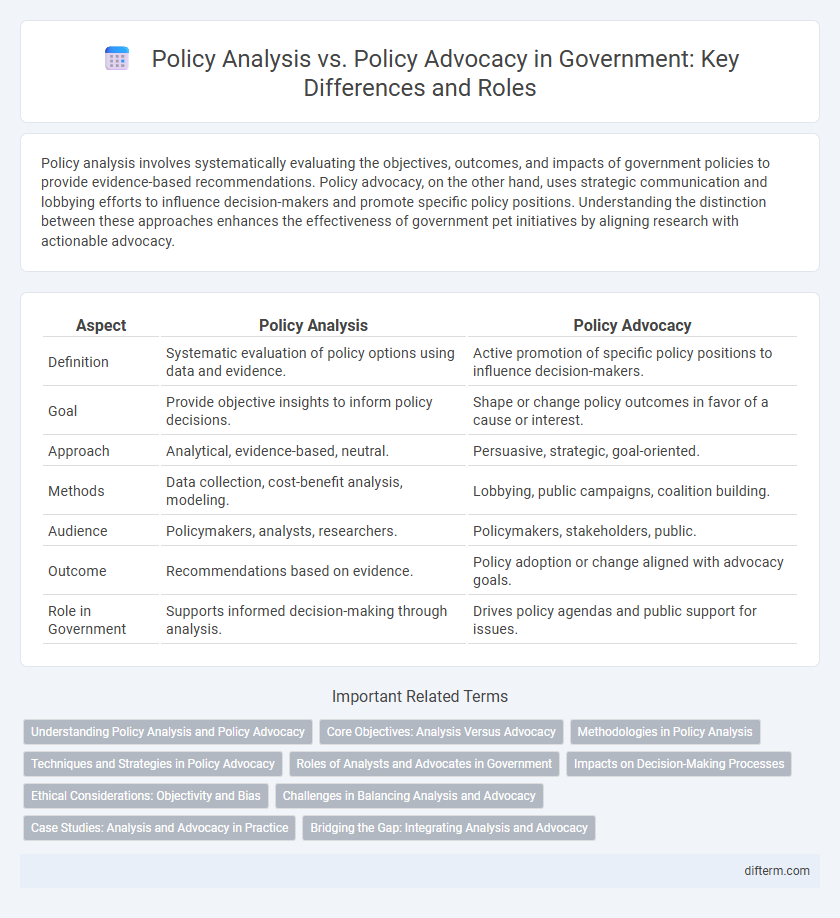Policy analysis involves systematically evaluating the objectives, outcomes, and impacts of government policies to provide evidence-based recommendations. Policy advocacy, on the other hand, uses strategic communication and lobbying efforts to influence decision-makers and promote specific policy positions. Understanding the distinction between these approaches enhances the effectiveness of government pet initiatives by aligning research with actionable advocacy.
Table of Comparison
| Aspect | Policy Analysis | Policy Advocacy |
|---|---|---|
| Definition | Systematic evaluation of policy options using data and evidence. | Active promotion of specific policy positions to influence decision-makers. |
| Goal | Provide objective insights to inform policy decisions. | Shape or change policy outcomes in favor of a cause or interest. |
| Approach | Analytical, evidence-based, neutral. | Persuasive, strategic, goal-oriented. |
| Methods | Data collection, cost-benefit analysis, modeling. | Lobbying, public campaigns, coalition building. |
| Audience | Policymakers, analysts, researchers. | Policymakers, stakeholders, public. |
| Outcome | Recommendations based on evidence. | Policy adoption or change aligned with advocacy goals. |
| Role in Government | Supports informed decision-making through analysis. | Drives policy agendas and public support for issues. |
Understanding Policy Analysis and Policy Advocacy
Policy analysis involves the systematic evaluation of public policies based on data, evidence, and potential outcomes to inform decision-making processes. Policy advocacy focuses on promoting specific policy proposals to influence public officials and stakeholders, aiming to achieve desired legislative or regulatory changes. Understanding the distinct roles of policy analysis and advocacy is essential for effective governance and shaping impactful public policies.
Core Objectives: Analysis Versus Advocacy
Policy analysis centers on objectively evaluating policy options based on empirical evidence and expected outcomes to inform decision-making processes. Policy advocacy emphasizes promoting specific policy positions or reforms by mobilizing public support and influencing stakeholders to achieve desired political goals. The core objective of analysis is informed neutrality, whereas advocacy prioritizes strategic persuasion and action.
Methodologies in Policy Analysis
Policy analysis employs systematic methodologies such as cost-benefit analysis, statistical modeling, and scenario evaluation to objectively assess policy options based on evidence and predicted outcomes. Techniques like stakeholder analysis, policy simulation, and impact assessment ensure data-driven decision-making within governmental frameworks. In contrast, policy advocacy primarily utilizes qualitative approaches emphasizing persuasive communication, coalition building, and value-driven argumentation to influence policy decisions.
Techniques and Strategies in Policy Advocacy
Policy advocacy employs targeted communication techniques such as framing, storytelling, and coalition-building to influence public opinion and decision-makers, while policy analysis focuses on evidence-based evaluation, cost-benefit assessments, and forecasting to inform policy decisions. Advocacy strategies include grassroots mobilization, lobbying, media engagement, and strategic alliances to amplify the policy message and drive legislative change. These approaches prioritize stakeholder engagement and narrative framing to create compelling arguments that resonate with both policymakers and the public.
Roles of Analysts and Advocates in Government
Policy analysts provide objective, evidence-based evaluations of government programs and potential policy impacts to inform decision-making processes. Advocates focus on promoting specific policy outcomes by mobilizing support, influencing public opinion, and engaging with stakeholders to advance their agenda. While analysts prioritize neutrality and data-driven insights, advocates emphasize persuasion and strategic communication to shape policy directions.
Impacts on Decision-Making Processes
Policy analysis provides objective, evidence-based evaluations of policy options, enhancing the quality and transparency of decision-making processes. In contrast, policy advocacy actively promotes specific policy choices, influencing decision-makers through persuasion and strategic communication. Both approaches impact government decisions by shaping priorities, resource allocation, and legislative outcomes.
Ethical Considerations: Objectivity and Bias
Policy analysis demands rigorous adherence to objectivity, ensuring decisions are grounded in impartial data evaluation and comprehensive evidence. Policy advocacy inherently involves promoting specific perspectives or outcomes, which can introduce bias and challenge ethical standards of neutrality. Ethical considerations in government require transparency about these roles to maintain trust and integrity in public decision-making processes.
Challenges in Balancing Analysis and Advocacy
Balancing policy analysis and policy advocacy poses significant challenges due to the risk of compromising objectivity when analysts engage in advocacy roles. Maintaining analytical rigor requires unbiased evaluation of data, while advocacy demands persuasive communication to influence decision-making. Navigating tensions between evidence-based recommendations and political agendas often complicates achieving credibility and impact in government policy processes.
Case Studies: Analysis and Advocacy in Practice
Case studies in government reveal that policy analysis involves systematic evaluation of policy options based on evidence and projected outcomes, while policy advocacy focuses on promoting specific policy choices through strategic communication and stakeholder engagement. Analysis employs data-driven methods to assess effectiveness, costs, and impacts, exemplified by comparative studies on healthcare reform or environmental regulation. Advocacy case studies demonstrate how interest groups and policymakers leverage public opinion and political momentum to advance legislative agendas.
Bridging the Gap: Integrating Analysis and Advocacy
Bridging the gap between policy analysis and policy advocacy involves combining rigorous data evaluation with strategic communication to influence decision-making effectively. Policy analysts provide evidence-based insights that inform advocacy strategies, ensuring campaigns are grounded in empirical research. Integrating analysis and advocacy enhances the impact of government policies by aligning factual rigor with persuasive outreach to stakeholders.
policy analysis vs policy advocacy Infographic

 difterm.com
difterm.com